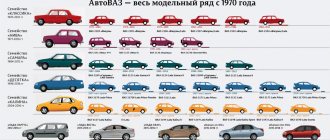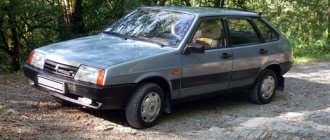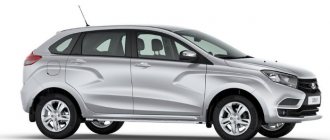On April 19, 1970, the first Zhiguli cars rolled off the main assembly line of the Volzhsky Automobile Plant. It was a VAZ-2101 model, popularly nicknamed “kopeyka”. After it there were five more models from the “classic” series, one Oka, a dozen Ladas. All these cars are not twins at all. Each VAZ has significant differences that are worth clearly seeing.
- Oka (1987—2008)
- LADA Samara family
- Family "ten"
VAZ-2110 (1995–2010)
- VAZ-2111 (1997–2010)
- VAZ-2112 (1998–2008)
- VAZ-1117 (2004–2018)
Classic Lada
The classic Zhiguli family consists of seven models of rear-wheel drive small class cars. There are two body types in the lineup - a four-door sedan and a five-door station wagon. All models are distinguished by a laconic design - now the appearance of Ladas may seem rustic, but for their time classic VAZs were quite stylish Soviet cars.
This infographic shows how the appearance of AvtoVAZ cars has changed from 1970 to 2022
VAZ-2101 (1970–1988) - the foreign public knew the model as LADA-120. It is a four-door sedan. The “penny” took away all external features from its Italian counterpart:
- cubic body shape (still with rounded corners, while subsequent models will become more “chopped”);
- a simple “facade” with a rectangular grille and a round pair of headlights;
- high roof line;
- rounded wheel arches;
- a laconic “rear” with vertically oriented lights and a small trunk lid.
The prototype for the first VAZ was the Fiat 124 (and quite legally, since an agreement was signed between the owner of the Italian concern and the Soviet Vneshtorg)
VAZ-2102 (1971–1986) - the five-door station wagon turned out to be spacious. In addition to the changed body type, the “two” is distinguished from the “kopek” by the license plate located on the fifth door and vertical rear lights.
The trunk of the VAZ-2102 could accommodate a lot of luggage (therefore, the car was the dream of every Soviet summer resident, fisherman, hunter and tourist)
VAZ-2103 (1972–1984) - the third model of the Lada (Lada 1500 in the export version) was launched from the assembly line in the same year as the “two”. The three-ruble note can be easily distinguished from the VAZ-2102, since they have different body types. But the large radiator grille with twin headlights “sitting” directly on it will help distinguish the VAZ-2103 from the previous sedan (“penny”).
Over 12 years, 1,304,899 of these Zhiguli “three rubles” were produced
VAZ-2104 (1984–2012) - station wagon, known in the West as Kalinka. The main difference from its predecessors is not round, but rectangular headlights. The lines of the body are more chopped (the roundings at the corners have become less pronounced than, for example, the “kopek”).
This five-door car demonstrates the classic Zhiguli design; The VAZ-2106 is larger than the “two” - it is 42 cm higher, and the luggage compartment is 112 cm longer
If the VAZ-2104 is the first domestic station wagon with rectangular headlights, then the VAZ-2105 is the first sedan with a similar form of optics. The body of the “five” is distinguished by its greater angularity. On the side there are wings with cut contours. The roof does not have a hint of rounding, the hood and luggage compartment are longer than those of a “kopek” or “troika”.
Export cars were called LADA-2105 Clasico; Soviet car enthusiasts nicknamed the car “stool”; “five” was liked by Soviet citizens who did not want to buy a station wagon, but wanted to have a car with a spacious trunk
VAZ-2106 (1976–2006) - popularly nicknamed the “Lada Six”; for foreign buyers the name Lada 1600 was used - a rear-wheel drive four-door sedan. A special feature of the VAZ-2106 is a round pair of headlights, “planted” not on the radiator grille, but in black plastic rectangles.
The VAZ-2106 became the most purchased car of the seventies and eighties in the USSR (in total, over 4.3 million “sixes” were produced and sold, while “threes” produced 1.3 million copies, and “fives” - 1.8 million)
VAZ-2107 (1982–2012) was made in accordance with the automotive trends of the eighties. At that time, angular, even slightly rough shapes, an abundance of chrome parts, and protruding parts (like the radiator grille, which began to protrude from the level of the hood) were fashionable. Like the VAZ-2106, the headlights are set in plastic rectangles (the difference is that the “six” has round front optics, while the “seven” has rectangular ones).
American automobile journalist Jeremy Clarkson, reviewing the VAZ-2107, called the car “a car for rude men who cannot tolerate anything feminine”
Extended Niva
Most of the models listed above have an extended five-door version. The first extended Niva, which created a lot of discussions among car enthusiasts, was the Niva 2131 - all other attempts to lengthen the Niva had not been successful. Despite the fact that the length of the body negatively affected off-road and dynamic qualities, it quickly gained popularity among domestic motorists. Probably the reason for this was that such a body is more comfortable for passengers and more spacious for various cargoes - this is quite the case, because the short-wheelbase Niva has very little space for rear passengers and a very small trunk.
Oka (1987—2008)
VAZ-111 (Lada Oka) is a Russian ultra-small class car. About 700 thousand models were rolled off the assembly line. The body type is a three-door hatchback. In an effort to reduce the size of the car, the developers sacrificed the harmonious appearance, which is why Oka was popularly nicknamed “Cheburashka”. Characteristic appearance features:
- miniature body;
- angular lines;
- rectangular optics;
- bumper made of unpainted plastic;
- shortened overhangs;
- short wheel arches;
- roof pillars too thin;
- large glass area.
Oka is 3200 mm long, 1420 mm wide, 1400 mm high
LADA Samara family
In 1984, the Volzhsky Automobile Plant decided to carry out a complete restyling of its VAZs and released the Lada Samara (aka VAZ-2108). In 1987, another model of this family was presented to the public - the VAZ-2109. The differences between the Samara and the classic Zhiguli were colossal, which divided Soviet citizens: some were outraged by the changed appearance of VAZs, others praised the manufacturers for innovations that separated domestic cars from the progenitor Fiat 124.
Initially, in the domestic market this line of VAZs was called “Sputnik”, and the name Lada Samara was used only for export cars
VAZ-2108 (1984–2003) - the three-door hatchback VAZ-2108 was popularly nicknamed “chisel” and “crocodile” for its elongated, narrowed front part. The car is spacious, as it was intended to be used as a family car. The body of the Samara is more rigid and, accordingly, safer than the “classics”. The rear seats are made with children in mind, and the trunk is spacious.
For the first time in the VAZ model range, VAZ-2108 began to be painted with metallized enamels in mass production
The VAZ-2109 (1987–2004) differs from the VAZ-2108 in that it is a five-door rather than a three-door hatchback. There are no other significant differences in appearance.
The width and length of the VAZ-2109 are the same as those of the VAZ-2108, and the height is an insignificant 4 cm greater
First release of Niva (VAZ-2121)
The Niva, which solemnly left the gates of the Volga Automobile Plant on April 5, 1977, laid the foundation for all subsequent modifications. The car had a short three-door wheelbase, spring suspension with an independent front axle, permanent all-wheel drive and a sealed body. All these qualities have not changed subsequently and are still used in the global automotive industry. The car's interior was more than comfortable and could compete with many foreign competitors. At that time, no one was particularly puzzled by the choice of colors, so the car was produced in a single color called “Golden Ocher”. The first Nivas were equipped with a 1.6-liter carburetor engine with a power of 80 hp, as well as a four-speed gearbox.
Family "ten"
In 1983, the design of a sedan based on the VAZ-2108 hatchback began. The project received the code name “family of ten”. The VAZ-2110 was released first, then the VAZ-2111 and VAZ-2112 station wagons went on sale.
VAZ-2110 (1995–2010)
VAZ-2110 - four-door front-wheel drive sedan
VAZ-2010 (LADA 110) is a four-door front-wheel drive sedan. It was distinguished by its “biodesign”, fashionable for the mid-1990s, with smooth outlines and maximum glazing area.
The VAZ-2110 has fairly large rear wings, but the car does not seem heavy due to the reduced size of the bumper
VAZ-2111 (1997–2010)
VAZ-2111 is a station wagon that is valued for its spacious luggage compartment with a wide opening.
In the front part, this model completely replicates the VAZ-2110.
The VAZ-2111 five-door sedan has a spacious trunk
VAZ-2112 (1998–2008)
VAZ-2112 (aka LADA 112 Coupe) - this hatchback is a symbiosis of the VAZ-2110 and 2111
It's just as roomy as a station wagon, but the model's appearance is lightened by the sharp transition from the roof to the tailgate. There are no corners, all lines are very smooth.
The body length of the VAZ 2112 is less than that of the VAZ-2110, but the capacity is greater (due to the increased luggage compartment)
Salon
The interior of the new Lada Priora NFR received a non-standard front dashboard architecture, with an instrument panel located above the steering wheel. The steering wheel itself is strongly beveled both at the top and at the bottom. The instrument panel is completely electronic. Its screen diagonal is 12.3 inches. The touchscreen of the multimedia system with a diagonal of 8 or 10 inches, depending on the configuration, is located in the center. The device supports Apple CarPlay and Android Auto interfaces.
Salon of the new Lada Priora NFR
Instrument panel Lada Priora NFR
Available options include 10 airbags, power front seats with a massager, Nappa leather upholstery, a panoramic roof, a premium Focal audio system, a surround-view camera system, adaptive cruise control, LED headlights, multi-zone climate control and a full package of warm options. The new Priora NFR can be equipped with a night vision system: an infrared camera is capable of displaying an image on the instrument panel and recognizing objects at a distance of up to 250 meters.
Lada Priora NFR 2022 - front interior
Lada Priora NFR 2022 - rear interior
Multimedia system Lada Priora NFR
LADA Kalina
Kalina are front-wheel drive cars of the “small class II group” (segment “B” by European standards). The family includes a sedan, a five-door hatchback and a station wagon. These three VAZs became the first AvtoVAZ “projects” developed using computer technology.
VAZ-1117 (2004–2018)
VAZ-1117 or LADA Kalina 1 - five-door station wagon
It has a narrowed front and a powerful rear with a large trunk lid. But the transitions between different parts of the car are smooth, so the car as a whole looks harmonious.
Lada Kalina has a shorter length and width than Lada Samara, therefore it has better maneuverability and is more suitable for driving on busy city roads
VAZ-1118 (2004–2013)
Lada Kalina Sedan seems small, but this is an optical illusion, since the dimensions are identical to 2117
VAZ-1118 (LADA Kalina sedan) seems smaller than a sedan, but this is an optical illusion, since their dimensions are the same. The front end can be called aggressive due to its predatory tapering headlights and narrow radiator grille. But the bumper is very neat, which makes the car light.
The rear of this model looks inconspicuous, as the only thing that can be distinguished from it is the massive trunk lid
VAZ-1119 (2006–2013)
The body of the VAZ-2119 is designed in the same style as that of the VAZ-1117
VAZ-1119 or LADA Kalina hatchback - the body of this model is designed in the same style as the VAZ-1117. The bumper is round in shape, the trunk lid is small and has a maximum glass area. The rear lights are arranged vertically and are more elongated in shape than those of the station wagon and sedan.
This model seems to be the neatest among its brothers in the LADA Kalina family, although its length is only 190 mm shorter, and there are no differences at all in width and height
Vesta on methane
Vesta on methane Recently, the Lada Vesta model range was replenished with a new AvtoVAZ product that runs on two types of fuel - natural gas, methane and gasoline.
This universal development allows you to travel long distances without refueling and significantly save money on fuel. This Lada Vesta model is made on the same platform as a regular sedan. The engine and exhaust system have been modified. The gas cylinder is located in the luggage compartment. The gas filling tube is located under the hatch cover, next to the neck of the gas tank.
The engine starts on gasoline, and then the engine switches to methane. If the gas runs out, it automatically switches to gasoline. You can also independently switch the fuel supply from different tanks using a special switch.
The equipment of the newcomer to the AvtoVAZ model range corresponds to the same three trim levels as a regular sedan. The choice of engine and transmission is limited to one option: a 106-horsepower engine paired with a manual transmission. Prices for the gas version start from 600 thousand rubles and end at 715 thousand.
LADA Granta
Lada Granta is a domestic front-wheel drive car, developed on the basis of LADA Kalina. The developers were given the goal of making a car that would be as close as possible to the Kalina in technical parameters and appearance, but to reduce its cost. The desire to reduce the cost undoubtedly affected the appearance of the car.
LADA Granta sedan differs from Kalina in how the car looks from the front. The front part features a stylish “pattern” of headlights, radiator grilles, license plate and logo sign. These elements are placed on a black backing in the shape of the letter X. From the side and rear, Granta repeats the LADA Kalina sedan.
Granta's trademark is the black X in the front of the car - it houses slanted headlights, a large brand logo and chrome “boomerangs” that visually unite the radiator and lower grilles
In 2014, production of Lada Granta Liftback began. Like the sedan, the liftback has an X-shaped design at the front. In addition, the model is distinguished by a convex roof, smoothly turning into a miniature rear part.
At the rear of the liftback are small horizontally elongated lights, a large fifth door and a bumper with a black insert stylized as a diffuser.
LADA Granta sport (2018 to this day) is a front-wheel drive sedan of the “subcompact” category. It is not particularly spacious, nor is the liftback. During its development, the emphasis was placed on modern dynamic design, aimed at a youth audience. A voluminous bumper, a wing on the trunk lid and massive 16-inch wheels with a large number of small spokes give it a sporty look.
LADA Granta sport (2018 to this day) - front-wheel drive sedan of the “subcompact” category
Why did you choose the EMP2 platform for the Priora in the new body?
According to the source, the choice of a third-party platform was caused by the need to load the assembly plant in Kaluga. This site is jointly owned by Stellantis and Mitsubishi. Mitsubishi itself has recently been part of the Renault-Nissan concern. All this makes the partnership of the two corporations a completely logical move. Stellantis currently assembles commercial vehicles and outdated Peugeot 408 and Citroen C4 models at this car plant. Demand for the latter has dropped to almost zero. In order to revive production, fresh models are needed. This could be the relatively affordable Peugeot 2008 crossover, which is currently being imported to Russia. The model is based on the EMP2 platform. At the same time, mastering the production of cars on a new platform is quite risky. If you fail to achieve high sales figures, the project may turn out to be unprofitable. Russians have not been favoring French brands lately.
New Lada Priora NFR 2022 - side view
From the above, it becomes clear that the production of a model on a new breed platform by the well-known Lada brand in Russia can be a good safety net. Full-size sedans are in good demand in our country, subject to a reasonable pricing policy. Take, for example, the extremely successful Toyota Camry and Kia K5. The new Lada Priora should be in no way inferior to its competitors with a more humane price tag, which means we can fully count on stable demand. Moreover, the price of foreign cars has grown very much over the past year (by 20% only according to the RRP), and there are also markups from dealers.
At the same time, the reputation of the Lada brand has grown greatly in recent years. Successful models like Vesta have proven themselves to be very good. Even the Lada Granta, after a series of modernizations, has become significantly better in terms of consumer qualities. The release of a higher-class model, which should be the new Lada Priora NFR, seems to be a completely logical move in such a situation.
Lada Largus
In 2011, AvtoVAZ presented to the public the first model from the Largus family. It was a C-class car, the prototype for which was the Romanian Dacia Logan MCV 2006. The line includes a passenger station wagon and a van.
Lada Largus R90 (2012 to this day) is a passenger station wagon in 5- and 7-seater versions. Its design is simple, devoid of any decorations.
Many people think that Largus looks awkward, but the developers decided to sacrifice the lightness of its appearance for the sake of spaciousness and ease of use of the passenger part of the car.
Largus F90 (2012 to this day) is the same R90. Only instead of the passenger part there is a cargo compartment, which has blank rear and side panels on the outside. The rear hinged doors can be locked in three positions. The side doors provide a wide opening angle, so that unloading can also be done through them.
The rear of the van and the doors are designed to make loading and unloading even large items easy
Interior
When starting to create the interior, the designers took into account some of the shortcomings of previous models and corrected them. Now the driver sits behind the wheel with his legs extended, and not as before, with his legs bent. The steering wheel itself has also changed its appearance, it has become much more beautiful. It has two points of support for the hands with a pillow, and it no longer blocks the visibility of the instruments. The designers have used soft plastic in the dashboard, which looks beautiful and feels good to the touch.
Thanks to this, the likelihood of any noise and squeaks is reduced. In new models, all large mechanical buttons are located on the sides of the dashboard. Climate control is intuitive.
The steering column has the ability to adjust the angle of vertical tilt and has a hydraulic booster. But, despite the updated steering wheel, its rim itself seems too thin to most. The rear seats are quite comfortable, but for three passengers it will already be a bit cramped. The luggage compartment has a volume of 480 liters.
The “Norma” package has front electric windows (it doesn’t matter whether there is a servo drive or not, they do not fully lower into the door), velor upholstery for seats and doors, as well as headrests on the rear sofa. The most expensive “Lux” configuration already has an on-board computer, heated rear-view mirrors and heated seats installed in the front.
The keys installed on the sides of the instrument panel make it impossible to forget that the car began to be designed back in the 1980s. Fuses and relays for the most important options of the car are located inside the car, on the left side under the steering wheel, which is very convenient.
In the famous “Samara” everything was not so convenient. We thought about loading narrow, long things - for this, the middle back of the rear sofa can be fully reclined, and the backs of the rear seats can also be reclined, but at a smaller angle.
Despite the still fairly limited space inside the car, updates to the front fascia and other elements have had a positive impact on the ergonomics of the cabin, which in turn has encouraged many consumers to buy the 2110.
The outside door handle is much better. The tongue from the famous “eight” disappeared, and now the door began to open by simply moving the lever up. Speaking about the doorway, it is worth saying that it has become quite convenient based on the width, but it is too small in height. Not to say that this will interfere, but the lack of headroom is noticeable.
However, the door itself no longer raises any complaints, partly thanks to the sharp upper corner. People of average height have no reason to be afraid, but those who are a little taller should be careful, as they can easily run into him.
In addition, the designers limited the opening angle of the door, which has only one intermediate fixed position. I was pleased that the threshold, which in 2108 was always covered with a layer of dirt in bad weather, now, thanks to the design features, always remains clean.
This point is very important, since when getting into a car you can easily get your clothes dirty if their edges touch the threshold. The driver is presented with a different dashboard, on which there is no longer the “oak” molded plastic - now the panel is made of soft elements reminiscent of the materials used in the VAZ “classic”.
Almost everywhere has become a little more comfortable thanks to the new upholstery of the chairs and the fleecy ceiling. Only the door trim remained molded, however, and it, in turn, became of higher quality.
Some nice touches include height-adjustable seat belts and door locking with central locking. The driver's seat has become more comfortable. The pillow and backrest were increased in width and began to distribute the load better.
You can no longer find that cushion in the lumbar region that bothers drivers, which was on the “eights”. Of course, there was no lateral support before and there is none now. The chair is still adjustable in only two positions, and the adjustments are still mechanical.
The gearshift lever of the VAZ 2110 was lengthened, which may be explained by the desire to reduce the effort when changing gears. The most important sensors - the speedometer and tachometer - now occupied the required space in the central part of the dashboard, and the direction indicators began to be placed on the sides. The center console has acquired indicators for the on-board control system.
Lada XRAY (2015 to this day)
LADA XRAY is a compact hatchback made in the style of an SUV (a sports-utilitarian car used daily and allowing it to accommodate a lot of cargo). The front bumper of the car is raised and has an X-shaped black pattern like the Lada Granta. A relief (stamping) appeared on the sidewalls, giving the car a dynamic appearance.
Appearance Lada XRAY has a rather aggressive look
The first AvtoVAZ car was rolled off the assembly line in 1970. Since then, the plant's designers have not been idle and are constantly coming up with new variations, focusing on the changing needs of society. The ancestor of the VAZ, the “kopek” has absolutely nothing in common with the modern Ladas Largus, XRAY, Granta.











